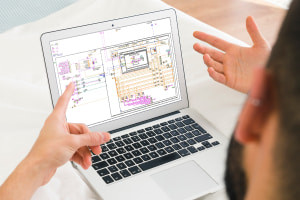As someone in the science or engineering fields, you will often need to develop software that interfaces with test and measurement equipment, to acquire and generate signals, analyze data, control systems, and automate processes. LabVIEW is a system engineering platform that makes doing all of this as quick and as painless as possible. Unlike traditional text-based programming languages, LabVIEW uses a graphical programming environment. You write a program in LabVIEW by drawing a diagram and we will look at the core components that make up most programs including different data types, and execution control mechanisms like loops, shift registers, and case structures. We will also explore how to debug and handle errors when your LabVIEW program doesn't work as it should and then use LabVIEW's express toolset to rapidly build applications for some of the most common-use cases.
Historically, LabVIEW has been widely adopted in the automated test realm, essentially becoming the standard in that application space, whereas more recently it has been gaining traction within the realm of industrial embedded monitoring and control. LabVIEW is a software development environment created by National Instruments and was originally focused on taking measurements from various lab instruments, but has expanded dramatically since its inception. Strictly speaking, LabVIEW is not a coding language, it is a development environment with the language actually called “G”, but most people refer to LabVIEW as if it a language in its own right (i.e., most people would say “it’s coded in LabVIEW”). There are thousands of different types of sensors out there, acquiring and measuring data from the real world. But how do you get that data into the computer for processing? LabView is a leading system-engineering platform for interfacing with data-acquisition hardware. In this LabView course, the demonstrations include how to program LabVIEW to control National Instruments data acquisition (DAQ) hardware, and acquire and generate analog and digital signals. Your learning provides guidance on choosing devices, setting up LabVIEW, connecting and simulating devices, and acquiring both analog and digital input and output. Other key themes include how to configure LabVIEW triggers, log data, read files, and connect third-party hardware with the wide variety of instrument drivers available for LabVIEW.
This course is great for beginners who want to learn the fundamental concepts of LabVIEW programming, as well as programmers and developers who aim to utilize the LabVIEW platform as their programming tool. For anyone in instrumentation testing or engineering, this course will teach you everything you need to know about LabVIEW from scratch and will provide you with a step-by-step guide on how the platform works to get you up and running with LabVIEW as quickly as possible.
What You Will Learn In This Free Course
View All Learning Outcomes View Less All Alison courses are free to enrol, study, and complete. To successfully complete this Certificate course and become an Alison Graduate, you need to achieve 80% or higher in each course assessment.
Once you have completed this Certificate course, you have the option to acquire an official Certificate, which is a great way to share your achievement with the world.
Your Alison certificate is:
- Ideal for sharing with potential employers.
- Great for your CV, professional social media profiles, and job applications.
- An indication of your commitment to continuously learn, upskill, and achieve high results.
- An incentive for you to continue empowering yourself through lifelong learning.
Alison offers 2 types of Certificate for completed Certificate courses:
- Digital Certificate: a downloadable Certificate in PDF format immediately available to you when you complete your purchase.
- Physical Certificate: a physical version of your officially branded and security-marked Certificate
All Certificate are available to purchase through the Alison Shop. For more information on purchasing Alison Certificate, please visit our FAQs. If you decide not to purchase your Alison Certificate, you can still demonstrate your achievement by sharing your Learner Record or Learner Achievement Verification, both of which are accessible from your Account Settings.











 Avg. Hours
Avg. Hours  Contains Video
Contains Video  CPD Accredited
CPD Accredited 
 Total XP:
Total XP: 
 Knowledge & Skills You Will Learn
Knowledge & Skills You Will Learn 







